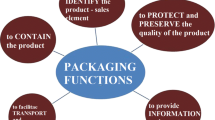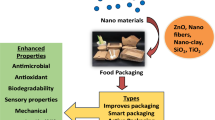Abstract
Active, intelligent, improved, and smart packaging used for foods and nutraceuticals are presented in this chapter, with emphasis on nanotechnological applications. There are many nanomaterials, including nano-clay, titanium nitride nanoparticle, nano-titanium dioxide, nano zinc oxide, and silver nanoparticle, used in active, intelligent, and smart packaging for functional and smart preservation purposes. Many nanomaterials like carbon nanotubes, nano-magnesium oxide, nano-titanium dioxide, nano-silver, nano-copper oxide, etc. confer good microbial inhibition properties, along with protecting the package contents. Unlike the traditional packaging systems, active, intelligent, and smart packages are purposefully made package systems to inculcate components that have the ability to discharge substances that destroy microorganisms, prevent oxidation, imbue water vapor, and prevent oxygen within the package and its environment. A combination of active formulations such as ethylene removers, absorbers, preservatives, water vapor, and O2 removers, antimicrobial agents, etc., with polymer, makes the package more capable of boosting the keeping quality while preserving the contents.
Access this chapter
Tax calculation will be finalised at checkout
Purchases are for personal use only
Similar content being viewed by others
References
Sharma C, Dhiman R, Rokana N, Panwar H. Nanotechnology: an untapped resource for food packaging. Front Microbiol. 2017;8:1735. https://doi.org/10.3389/fmicb.2017.01735.
Gokularaman S, Stalin Cruz A, Pragalyaashree MM, Nishadh A. Nanotechnology approach in food packaging—review. J Pharm Sci Res. 2017;9(10):1743–9.
Primožič M, Knez Ž, Leitgeb M. (Bio) Nanotechnology in food science—food packaging. Nanomaterials. 2021;11:292. https://doi.org/10.3390/nano11020292.
Ravichandran R. Nanoparticles in drug delivery: potential green nanobiomedicine applications. Int J Nanotechnol Biomed. 2010;1:108–30.
Wahab A, Rahim AA, Hassan S, Egbuna C, Manzoor MF, Okere KJ, Walag AMP. Application of nanotechnology in the packaging of edible materials. In: Egbuna C, Mishra AP, Goyal MR, editors. Preparation of phytopharmaceuticals for the management of disorders. San Diego, CA: Academic; 2021. p. 215–25.
Kuswandi B. Nanotechnology in food packaging. Chemo and Biosensors Group, Faculty of Pharmacy, University of Jember; 2016.
Pal M. Nanotechnology: a new approach in food packaging. J Food Microbiol Saf Hyg. 2017;2:2. https://doi.org/10.4172/2476-2059.1000121.
Awuchi CG, Twinomhwezi H, Choudghal S, Khan MG, Yezdani U, Akram MV. Nanotechnology application in food science and nutrition and its safety issues; a review. Adv Biores. 2020;11(6):23–35. https://doi.org/10.15515/abr.0976-4585.11.6.2335.
Tager J. Nanomaterials in food packaging: FSANZ fails consumers gain. Chain Reaction. 2014;122:16–7.
Duncan TV. Applications of nanotechnology in food packaging and food safety: barrier materials, antimicrobials and sensors. J Colloid Interface Sci. 2011;363:1–24.
Mihindukulasuriya SDF, Lim LT. Nanotechnology development in food packaging: a review. Trends Food Sci Technol. 2014;40(2014):149–67.
Montazer M, Harifi T. New approaches and future aspects of antibacterial food packaging: from nanoparticles coating to nanofibers and nanocomposites, with foresight to address the regulatory uncertainty. In: Grumezescu AM, editor. Food package. San Diego, CA: Academic; 2017. p. 533–59.
Weiss J, Takhistov P, McClements DJ. Functional materials in food nanotechnology. J Food Sci. 2006;71(9):107–16.
Mercea P. Models for diffusion in polymers. In: Piringer OG, Baner AL, editors. Plastic packaging. 2nd ed. Weinheim: Wiley-VCH GmbH and Co. KGaA; 2008.
Bradley EL, Castle L, Chaudhry Q. Applications of nanomaterials in food packaging with a consideration of opportunities for developing countries. Trends Food Sci Technol. 2011;22:604–10.
Alfei S, Marengo B, Zuccari G. Nanotechnology application in food packaging: a plethora of opportunities versus pending risks assessment and public concerns. Food Res Int. 2020;137:109664.
Bikiaris DN, Triantafyllidis KS. HDPE/cu-nanofiber nanocomposites with enhanced antibacterial and oxygen barrier properties appropriate for food packaging applications. Mater Lett. 2013;93:1–4. https://doi.org/10.1016/j.matlet.2012.10.128.
Egbuna C, Parmar VK, Jeevanandam J, Ezzat SM, Patrick-Iwuanyanwu KC, Adetunji CO, Khan J, et al. Toxicity of nanoparticles in biomedical application: nanotoxicology. J Toxicol. 2021;2021:9954443. https://doi.org/10.1155/2021/9954443.
Cavaliere E, De Cesari S, Landini G, Riccobono E, Pallecchi L, et al. Highly bactericidal ag nanoparticle films obtained by cluster beam deposition. Nanomed Nanotechnol Biol Med. 2015;11:1417–23. https://doi.org/10.1016/j.nano.2015.02.023.
Emamifar A, Kadivar M, Shahedi M, Soleimanian-Zad S. Evaluation of nanocomposites packaging containing Ag and ZnO on shelflife of fresh orange juice. Innov Food Sci Emerg Technol. 2011;11:742–8. https://doi.org/10.1016/j.ifset.2010.06.003.
Busolo MA, Fernandez P, Ocio MJ, Lagaron JM. Novel silver based nanoclay as an antimicrobial in polylactic acid food packaging coatings. Food Addit Contam. 2010;27:1617–26. https://doi.org/10.1080/19440049.2010.506601.
Fortunati E, Peltzer M, Armentano I, Jimenez A, Kenny JM. Combined effects of cellulose nanocrystals and silver nanoparticles on the barrier and migration properties of PLA nanobiocomposites. J Food Eng. 2013a;118:117–24. https://doi.org/10.1016/j.jfoodeng.2013.03.025.
Fortunati E, Puglia D, Luzi F, Santulli C, Kenny JM, Torre L. Binary PVA bio-nanocomposites containing cellulose nanocrystals extracted from different natural sources: part I. Carbohydr Polym. 2013b;97:825–36. https://doi.org/10.1016/j.carbpol.2013.03.075.
Sadeghnejad A, Aroujalian A, Raisi A, Fazel S. Antibacterial nano silver coating on the surface of polyethylene films using corona discharge. Surf Coat Technol. 2014;245:1–8. https://doi.org/10.1016/j.surfcoat.2014.02.023.
Fernandez A, Picouet P, Lloret E. Cellulose-silver nanoparticle hybrid materials to control spoilage-related microflora in absorbent pads located in trays of fresh-cut melon. Int J Food Microbiol. 2010;142:222–8. https://doi.org/10.1016/j.ijfoodmicro.2010.07.001.
Smolkova B, El Yamani N, Collins AR, Gutleb AC, Dusinska M. Nanoparticles in food. Epigenetic changes induced by nanomaterials and possible impact on health. Food Chem Toxicol. 2015;77:64–73. https://doi.org/10.1016/j.fct.2014.12.015.
Ranjan S, Dasgupta N, Chakraborty AR, Samuel SM, Ramalingam C, Shanker R, et al. Nanoscience and nanotechnologies in food industries: opportunities and research trends. J Nanopart Res. 2014;16:2464. https://doi.org/10.1007/s11051-014-2464-5.
Rhim JW, Park HM, Ha CS. Bio-nanocomposites for food packaging applications. Prog Polym Sci. 2013;38:1629–52. https://doi.org/10.1016/j.progpolymsci.2013.05.008.
Brandelli A, Brum LFW, dos Santos JHZ. Nanostructured bioactive compounds for ecological food packaging. Environ Chem Lett. 2017;15:193–204. https://doi.org/10.1007/s10311-017-0621-7.
Lopez-Rubio A, Gavara R, Lagaron JM. Bioactive packaging: turning foods into healthier foods through biomaterials. Trends Food Sci Technol. 2006;17:567–75. https://doi.org/10.1016/j.tifs.2006.04.012.
Fernandez A, Cava D, Ocio MJ, Lagaron JM. Perspectives for biocatalysts in food packaging. Trends Food Sci Technol. 2008;19:198–206. https://doi.org/10.1016/j.tifs.2007.12.004.
Rhim JW, Ng PKW. Natural biopolymer-based nanocomposite films for packaging applications. Crit Rev Food Sci Nutr. 2007;47:411–33. https://doi.org/10.1080/10408390600846366.
Gopinath S, Sugunan S. Enzymes immobilized on montmorillonite K 10: effect of adsorption and grafting on the surface properties and the enzyme activity. Appl Clay Sci. 2007;35:67–75. https://doi.org/10.1016/j.clay.2006.04.007.
Sharma AL, Singhal R, Kumar A, Rajesh Pande KK, Malhotra BD. Immobilization of glucose oxidase onto electrochemically prepared poly (aniline-co-fluoroaniline) films. J Appl Polym Sci. 2004;91:3999–4006. https://doi.org/10.1002/app.13553.
Qhobosheane M, Santra S, Zhang P, Tan WH. Biochemically functionalized silica nanoparticles. Analyst. 2001;126:1274–8. https://doi.org/10.1039/b101489g.
Macwan D, Dave PN, Chaturvedi S. A review on nano- TiO2 sol–gel type syntheses and its applications. J Mater Sci. 2011;46:3669–86. https://doi.org/10.1007/s10853-011-5378-y.
Montazer M, Seifollahzadeh S. Enhanced self-cleaning, antibacterial and UV protection properties of nano TiO2 treated textile through enzymatic pretreatment. Photochem Photobiol. 2011;87:877–83. https://doi.org/10.1111/j.1751-1097.2011.00917.x.
Cerrada ML, Serrano C, Sánchez-Chaves M, Fernández-García M, Fernández-Martín F, de Andrés A. Self-sterilized EVOHTiO2 nanocomposites: effect of TiO2 content on biocidal properties. Adv Funct Mater. 2008;18:1949–60. https://doi.org/10.1002/adfm.200701068.
Maneerat C, Hayata Y. Antifungal activity of TiO2 photocatalysis against Penicillium expansum in vitro and in fruit tests. Int J Food Microbiol. 2006;107:99–103. https://doi.org/10.1016/j.ijfoodmicro.2005.08.018.
Awuchi CG, Ondari EN, Ofoedu CE, Chacha JS, Rasaq WA, Morya S, Okpala COR. Grain processing methods’ effectiveness to eliminate mycotoxins: an overview. Asian J Chem. 2021a;33(10):2267–75. https://doi.org/10.14233/ajchem.2021.23374.
Awuchi CG, Ondari EN, Ogbonna CU, Upadhyay AK, Baran K, Okpala COR, Korzeniowska M, Guiné RPF. Mycotoxins affecting animals, foods, humans and plants: types, occurrence, toxicities, action mechanisms, prevention and detoxification strategies—a revisit. Foods. 2021b;10:1279. https://doi.org/10.3390/foods10061279.
Cioffi N, Torsi L, Ditaranto N, Tantillo G, Ghibelli L, Sabbatini L, et al. Copper nanoparticle/polymer composites with antifungal and bacteriostatic properties. ChemMater. 2005;17:5255–62. https://doi.org/10.1021/cm0505244.
Sheikh FA, Kanjawal MA, Saran S, Chung WJ, Kim H. Polyurethane nanofibers containing copper nanoparticles as future materials. Appl Surf Sci. 2011;257:3020–6. https://doi.org/10.1016/j.apsusc.2010.10.110.
Chatterjee AK, Chakraborty R, Basu T. Mechanism of antibacterial activity of copper nanoparticles. Nanotechnology. 2014;25:135101. https://doi.org/10.1088/0957-4484/25/13/135101.
Vermeiren L, Devlieghere F, Debevere J. Effectiveness of some recent antimicrobial packaging concepts. Food Addit Contam. 2002;19:163–71.
Fujishima A, Rao TN, Tryk DA. Titanium dioxide photocatalysis. J Photochem Photobiol Phytochem Rev. 2000;1:1–21. https://doi.org/10.1016/S1389-5567(00)00002-2.
Kong H, Song J, Jang J. Photocatalytic antibacterial capabilities of TiO(2)-biocidal polymer nanocomposites synthesized by a surfaceinitiated photopolymerization. Environ Sci Technol. 2010;44:5672–6. https://doi.org/10.1021/es1010779.
Farhoodi M. Nanocomposite materials for food packaging applications: characterization and safety evaluation. Food Eng Rev. 2016;8:35–51. https://doi.org/10.1007/s12393-015-9114-2.
Robertson JMC, Robertson PKJ, Lawton LA. A comparison of the effectiveness of TiO2 photocatalysis and UVA photolysis for the destruction of three pathogenic micro-organisms. J Photochem Photobiol. 2005;175:51–6. https://doi.org/10.1016/j.jphotochem.2005.04.033.
Li Z, Sheng C. Nanosensors for food safety. J Nanosci Nanotechnol. 2014;14:905–12. https://doi.org/10.1166/jnn.2014.8743.
Pramanik PKD, Solanki A, Debnath A, Nayyar A, El-Sappagh S, Kwak K. Advancing modern healthcare with nanotechnology, nanobiosensors, and internet of nanothings: taxonomies, applications, architecture, and challenges. IEEE Access. 2020;8:65230–66.
Wu D, Hou S, Chen J, Sun Y, Ye X, Liu D, Wang Y. Development and characterization of an enzymatic time-temperature indicator (TTI) based on Aspergillus niger lipase. LWT- Food Sci Technol. 2015;60(2):1100–4. https://doi.org/10.1016/j.lwt.2014.10.011.
Nile SH, Baskar V, Selvaraj D, Nile A, Xiao J, Kai G. Nanotechnologies in food science: applications, recent trends, and future perspectives. Nano Micro Lett. 2020;12:45. ISSN 2311-6706.
Spielman S. Smart packaging: connecting the physical with the digital. 2021. https://www.foodengineeringmag.com/articles/99310-smart-packaging-connecting-the-physical-with-the-digital. Accessed 4 Oct 2021.
Cammarelle A, Viscecchia R, Bimbo F. Intention to purchase active and intelligent packaging to reduce household food waste: evidence from Italian consumers. Sustainability. 2021;13:4486. https://doi.org/10.3390/su13084486.
Salgado PR, Di Giorgio L, Musso YS, Mauri AN. Recent developments in smart food packaging focused on biobased and biodegradable polymers. Front Sustain Food Syst. 2021;5:630393. https://doi.org/10.3389/fsufs.2021.630393.
Eghbal N, Dumas E, Yarmand MS, Mousavi ME, Oulahal N, Gharsallaoui A. Antimicrobial films based on pectin and sodium caseinate for the release of antifungal natamycin. J Food Process Preserv. 2019;43:e13953. https://doi.org/10.1111/jfpp.13953.
Ehsani A, Hashemi M, Aminzare M, Raeisi M, Afshari A, Mirza Alizadeh A, et al. Comparative evaluation of edible films impregnated with sage essential oil or lactoperoxidase system: impact on chemical and sensory quality of carp burgers. J Food Process Preserv. 2019;43:e14070. https://doi.org/10.1111/jfpp.14070.
Bhargava N, Sharanagat VS, Mor RS, Kumar K. Active and intelligent biodegradable packaging films using food and food waste-derived bioactive compounds: a review. Trends Food Sci Technol. 2020;105:385–401. https://doi.org/10.1016/j.tifs.2020.09.015.
Assis RQ, Lopes SM, Costa TMH, Flôres SH, de Rios AO. Active biodegradable cassava starch films incorporated lycopene nanocapsules. Ind Crop Prod. 2017;109:818–27. https://doi.org/10.1016/j.indcrop.2017.09.043.
Author information
Authors and Affiliations
Editor information
Editors and Affiliations
Rights and permissions
Copyright information
© 2022 The Author(s), under exclusive license to Springer Nature Switzerland AG
About this chapter
Cite this chapter
Awuchi, C.G., Dendegh, T.A. (2022). Active, Smart, Intelligent, and Improved Packaging. In: Egbuna, C., Jeevanandam, J., C. Patrick-Iwuanyanwu, K., N. Onyeike, E. (eds) Application of Nanotechnology in Food Science, Processing and Packaging . Springer, Cham. https://doi.org/10.1007/978-3-030-98820-3_12
Download citation
DOI: https://doi.org/10.1007/978-3-030-98820-3_12
Published:
Publisher Name: Springer, Cham
Print ISBN: 978-3-030-98819-7
Online ISBN: 978-3-030-98820-3
eBook Packages: Chemistry and Materials ScienceChemistry and Material Science (R0)




